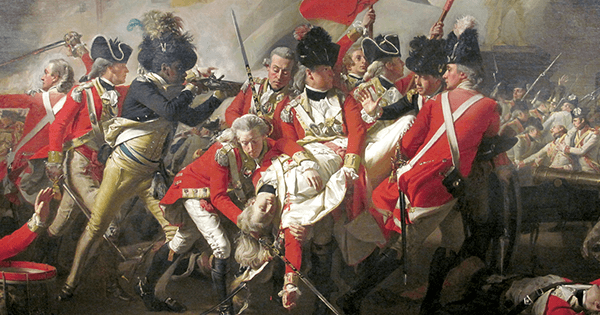
A Revolution in Color: The World of John Singleton Copley by Jane Kamensky; Norton, 544 pp., $35
No greater compliment can go to an artist than when two nations lay claim to him or her. George Frideric Handel (1685–1759) is a famous example. Born in Halle and raised in Hamburg, the composer made such an ineradicable impression on the British that his German origins are usually appended in very tiny writing. Then there is Johann Sebastian Bach’s youngest son, Johann Christian Bach (1735–1782), born in Leipzig but known as the “English Bach,” who was painted by Thomas Gainsborough. Even John Singer Sargent (1856–1925), born in Florence to American parents, was so much at home in London during World War I that he became a British war artist for the Imperial War Museum.
To this list of luminaries we should add John Singleton Copley (1738–1815), perhaps the greatest and most influential painter in colonial America. His 350 works of art—most of them portraits, but including his enormous canvases of “history” paintings—illustrate the rapid rise of a phenomenal young portraitist. Starting as a teenager, Copley moved quickly from the stiff and lifeless genre of portrait painting so typical of his earliest anonymous works to a mastery of delineation that was immediately recognized at home and abroad. His works fill American museums, while the Tate in London, among other museums, labels his works as “British school.”
As Jane Kamensky’s detailed and searching study makes clear, the truth is that Copley belonged to New England in the days when Boston was still a colonial outpost and a predictably provincial one. Even after he moved to London in 1775, his paintings retained a directness and simplicity of manner, along with a freedom of execution, that mark his work as uniquely American.
Like J. M. W. Turner in London, Copley in Boston was born within sight of great ocean vessels, arriving with their cargoes of “Carolina indigo and German steel and Madeira wine.” According to his biographer, he could see boats moored a matter of yards from his house, although this proximity would not have the same decisive effect on the young Copley as it did on the great English painter.
Copley, like Turner, grew up in humble circumstances; his widowed mother, Mary Singleton Copley, with young children to support, eked out a modest living by running a tobacco shop on the wharf. When she remarried, it was by great good luck to Peter Pelham, a portrait painter of sorts and an expert engraver in mezzotint, “capable of teasing velvety blacks and liquid grays from inked copper plates.” Pelham specialized in engraving famous faces, most of them English, because they sold very well. For Copley’s future career, not to mention the fortune of his family, his mother could not have made a better choice.
By the time Copley was 20, his mastery of the portrait was so far advanced and so well received that he was able to buy a modest house for his family. Small, thin, not handsome, and tending to stammer, he admired the self-assurance and commanding style of military men and developed an ability to elicit revealing expressions from such unlikely subjects. His canvas, painted when he was still in his teens, of Major George Scott (c. 1758) reveals the arrogance of a man far too pleased with himself.
But it was the offbeat subject of A Boy With a Flying Squirrel (1765), that marked his arrival as an artist of phenomenal accomplishment and originality. The work was exhibited in London in 1766 and extravagantly admired, not just by his countryman Benjamin West but by Sir Joshua Reynolds as well. After an obligatory tour of the continent, begun in 1774, Copley settled in London with his wife and children for good.
Kamensky makes frequent references to parallels between Copley’s revolutionary style and the actual revolution in Boston that heralded the arrival of a new country. That the artist was in Boston before the Revolution, if not for the inevitable war, was fortuitous. His paintings of such figures as Nicholas Boylston, the great benefactor of Harvard University, and Thomas Mifflin, member of the Continental Congress and governor of Pennsylvania, not to mention Samuel Adams and Paul Revere, are precious portrayals of the personalities whose lives were being played out on a world stage.
The title of the book, A Revolution in Color, suggests that the reader should see the artist’s career in the context of the events he witnesses, as if he somehow sums up and exemplifies all that is meant by the heroic spirit of a new, evolving nation. The cover illustrations depict details from the scene of a battle: dying men, red-coated soldiers, bayonets, and a fleeing group of mother, son, infant, and nurse, said to be modeled on the artist’s family.
The problem here is that Copley never painted a battle scene depicting the American Revolution, or indeed, a single historical painting that had anything to do with American history. The canvas from which the cover details come is a scene showing the death of a young British officer, Major Peirson, who commanded an army that successfully fended off a French attack on the island of Jersey in 1781. Copley preferred to paint scenes from British history, such as The Death of the Earl of Chatham, and the cover of Kamensky’s book is therefore misleading.
Copley does not need any attempt to give his life such a heroic dimension. He is heroism itself, as he emerges from penniless obscurity to fame and fortune on two continents, and the lasting quality of his achievement is not in doubt. After viewing the work of great Italian artists in Rome, Copley expressed his wish to follow in their footsteps and become “immortalised.” He wanted to be “admired as long as this Earth shall continue.” He got his wish.

